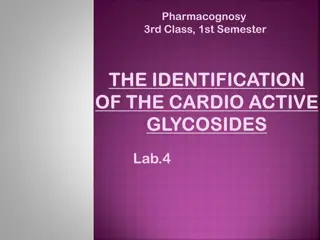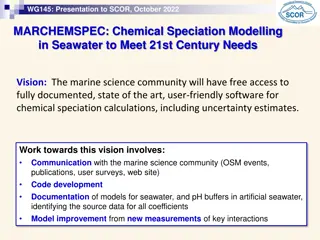Zhejiang Supershine Household Chemical Technology Co., Ltd. - Daily Chemical Manufacturer Overview
Zhejiang Supershine Household Chemical Technology Co., Ltd. is a well-known daily chemical manufacturer in China with a focus on household cleaning products. They offer a range of products including dishwasher cleaning tablets, coffee machine cleaning tablets, and multi-effect floor cleaning tablets
0 views • 35 slides
Acetyl Chloride Manufacturer Company
Dive into the world of chemical innovation with Modi Chemical, a premier Acetyl Chloride Manufacturer in Gujarat. Explore the cutting-edge processes and stringent quality standards that define our production, ensuring excellence in every molecule. With a commitment to sustainability and technologica
4 views • 1 slides
Mono Chloro Benzene Manufacturer in Gujarat
Discover excellence in chemical manufacturing with Modi Chemical, a premier Mono Chloro Benzene Manufacturer in Gujarat. Experience top-quality products and unmatched service, meticulously crafted to meet your industrial needs. Partner with us to access cutting-edge solutions and unparalleled expert
2 views • 1 slides
Chemical Agents Awareness Training Overview
This training module covers standardized awareness and authorized training on chemical agents, including toxic industrial chemicals, riot control agents, and chemical warfare agents. Participants will learn about the physiological signs/symptoms, advantages/disadvantages of using chemical agents for
2 views • 20 slides
Chemical Formulas, Reactions, and Equations
Explore the world of chemical formulas, reactions, and equations, understanding how they identify substances and represent the composition of compounds. Learn about the significance of balanced chemical equations and the role of subscripts in indicating the number of atoms present in a molecule. Dis
1 views • 44 slides
Enhancing Chemical Formula Writing Skills for Students
This action research focuses on improving students' ability to write and name chemical formulas. The study addresses challenges in understanding and applying chemical concepts in a general chemistry course. Strategies include utilizing worksheets, group collaboration, and mobile applications to enha
3 views • 13 slides
Chemical Kinetics: Rates of Reactions and Factors Influencing Them
Chemical kinetics delves into the speed of chemical reactions and the factors that influence reaction rates. This field explores how collisions between atoms, ions, or molecules drive chemical reactions, as well as the role of catalysts, reactant concentration, temperature, and surface area. By unde
0 views • 32 slides
Chemical Equations and Formulae
Learn to construct balanced chemical equations for known reactions, deduce signs and charges of simple ions, and create chemical formulae for ionic compounds. Understand the concepts of reactants, products, molecules, giant structures, state symbols, and chemical formulas for various substances. Gai
6 views • 7 slides
Speciation and Extinction in Evolutionary Biology
Explore the modes of speciation and causes of extinction in the evolutionary process. Learn how species evolve to become distinct through geographic isolation and reduced gene flow. Understand the implications of extinction and its impact on biodiversity. Images and descriptions provided offer insig
0 views • 33 slides
Chemical Equilibrium in Reversible Reactions and Laws
Chemical equilibrium in reversible reactions involves the balance between forward and backward reactions, as governed by laws like the law of mass action and the law of chemical equilibrium. These laws help in understanding the rates of reactions, equilibrium constants, and the relationship between
1 views • 12 slides
Chemical Disasters in the Indian Chemical Industry
Chemical disasters pose a significant threat to the Indian chemical industry, impacting human lives, property, and the environment. Factors contributing to these disasters include ageing process plants, human errors, design defects, and natural events. Proper prevention measures, such as hazard iden
0 views • 13 slides
Identification of Cardioactive Glycosides Through Chemical Tests
The laboratory experiments focus on identifying cardioactive glycosides through chemical tests like Baljets Test and Keller-Killians Test. These tests involve reactions with specific reagents to observe color changes and layer formations, helping in the identification of different parts of the glyco
3 views • 11 slides
Enhancing Synergies for Resilient Tomorrow: Chemical Waste Management Project Overview
Enhancing Synergies for a Resilient Tomorrow outlines a project aimed at strengthening the Federated States of Micronesia's capacity in chemical management. The project focuses on monitoring and evaluating chemical use, enhancing legislative frameworks, and establishing a central database for chemic
1 views • 12 slides
Industry-Oriented Knowledge Programme by CHEM.SKILL.DEVELOPMENT.CENTRE June 2022
CHEM.SKILL.DEVELOPMENT.CENTRE (CSDC) offers an industry-oriented knowledge programme to bridge the gap between theory and practice. The objectives include enhancing employability, providing practical knowledge, building confidence, and understanding industry practices. The programme's strategy invol
0 views • 14 slides
Insights into Sexual Selection and Speciation in Evolutionary Biology
Explore the fascinating concepts of sexual selection, sex differences, and speciation in evolutionary biology through topics such as ornamentation in males, survival advantages, and the influence of mate preferences on offspring fitness. Dive into the mechanisms that drive the evolution of species a
1 views • 26 slides
Evolution of Chemical Technicians in ACS: A Historical Overview
The history of chemical technicians within the American Chemical Society (ACS) is traced from the early formation of committees to the advancement of technician roles in the workplace. The involvement of committees such as Committee on Technician Activities (CTA) and Committee on Technician Educatio
1 views • 18 slides
EPA Oil and Gas VOC Speciation Improvement Efforts
EPA's VOC Speciation transforms inventory species into Air Quality model species to support chemistry, ozone, and aerosol chemistry. The Speciate4.5 update in 2016 added oil and gas profiles, including location-specific uncontrolled profiles and WRAP profiles for various basins. The Uinta TMSR profi
2 views • 10 slides
Chemical Kinetics and Numerical Solvers in Chemistry
Explore the principles of chemical kinetics and the use of numerical solvers to compute concentrations over time, considering explicit and implicit methods. Understand stability and positivity requirements in solvers and the importance of characteristic time scales in chemical systems. Dive into a s
0 views • 5 slides
Overview of Chemical Reactor Design and Operation
Chemical reactor design involves studying the rates and mechanisms of chemical reactions, as well as the design of reactors for these reactions on a commercial scale. This field combines principles from thermodynamics, chemical kinetics, fluid mechanics, mass transfer, heat transfer, and economics t
0 views • 12 slides
Chemical Changes and Reactions
Explore the concepts of chemical and physical changes, including balancing chemical equations, physical properties, and examples of chemical reactions. Learn to distinguish between physical and chemical changes through visual aids and learning checks.
0 views • 24 slides
Speciation in Biology: A Comprehensive Approach
This course introduces the concept of speciation through a focus on evolutionary processes, genetic drift, and selection pressures. Designed for science majors, the curriculum includes active learning activities and assessments to address misconceptions and promote in-depth understanding of biodiver
0 views • 17 slides
Chemical Hygiene Plan & Laboratory Safety Overview
This document outlines the Chemical Hygiene Plan and Laboratory Safety procedures, including responsibilities, standard operating procedures, controlling chemical exposures, and the use of engineering controls like chemical fume hoods. It serves as a guide for maintaining a safe working environment
0 views • 90 slides
Evolutionary Forces and Speciation in Iguanas: A Study from the Caribbean
After two hurricanes in 1995 carried green iguanas from Guadalupe to Anguilla, evolutionary forces are expected to act on the new iguana population. A study hypothesizes allele frequency differences between the populations, potentially leading to speciation by 2050. The morphospecies concept was use
0 views • 10 slides
Biodiversity, Natural Selection, and Speciation in Conservation and Biodiversity (IBESS Topic 4)
Understanding biodiversity in ecosystems, the principles of natural selection according to Charles Darwin, and the concept of speciation. Explore the importance of genetic diversity, habitat diversity, and species diversity within ecosystems, and learn how natural selection drives evolution. Discove
0 views • 23 slides
Physical and Chemical Changes in Science Class
Explore the concepts of physical changes and chemical reactions in this interactive science lesson. Students will differentiate between the two types of changes, identify evidence for each, categorize examples, and discuss key concepts with their peers at the table. Through videos and discussions, t
0 views • 21 slides
ASU EHS & FSE Chemical Approval Process Guidelines
Detailed guidelines and forms for the chemical approval process at ASU, including links to important resources, forms for new chemical purchases and transfers, responsibilities for lab managers, and procedures for chemical transfers. The process involves completing forms such as the Prior Approval A
0 views • 5 slides
Chemical Reactions in Daily Life
Understanding chemistry, particularly chemical reactions, is crucial for our daily lives. Chemical reactions involve the transformation of substances into different ones, described by reactants and products in equations. By learning about chemical equations, word equations, formula equations, and th
0 views • 15 slides
Chemical Speciation Modelling in Seawater for 21st Century Needs
Chemical speciation modelling in seawater is advancing to meet the needs of the marine science community in the 21st century. The vision is to provide free access to user-friendly software for calculations with uncertainty estimates. This involves communication with the community, code development,
0 views • 4 slides
Ionic Bonding and Lattice Energy in Chemistry
Chemical bonds play a crucial role in holding atoms together in molecules. This course explores the concept of chemical bonding, focusing on ionic bonds and lattice energy. Topics covered include the different types of chemical bonds, such as electrovalent and coordinate bonds, as well as the models
0 views • 22 slides
Meat Adulteration and Substitution in Food Processing
In meat processing, there is a risk of substituting lower quality meats for higher quality ones to deceive consumers. Differentiating between animal meats is crucial, especially in minced or sausage forms. Horseflesh, with its high glycogen content, presents a unique challenge. Methods for meat spec
0 views • 7 slides
Enhancing Watershed Nutrient Response and Climate Resilience
The Watershed Group aims to enhance nutrient response to flow and sediment changes, improve N and P speciation, and integrate climate change effects into BMP effectiveness estimates. Strategies include spatially varying N relationships, investigating WWTPs and stormwater systems, and reviewing speci
0 views • 7 slides
Best Practices for Chemical Hygiene and Safety in Laboratories
Responsibilities of the Chemical Hygiene Officer (CHO) include implementing the Chemical Hygiene Plan (CHP), monitoring the chemical life cycle, arranging staff training, conducting safety inspections, assisting staff, and maintaining records. Principals and Science Department Heads support staff in
0 views • 18 slides
Introduction to Chemical Reaction Engineering
Chemical Reaction Engineering (CRE) is crucial for understanding how chemical reactors operate in various processing operations. This field involves reactor design by integrating factors such as thermodynamics, kinetics, fluid mechanics, heat transfer, and economics. CRE aims to effectively design a
0 views • 16 slides
The Advantages of Using Chemical and Acid Resistant Heat Transfer Labels
If you belong to the chemical industry, then you must be worried about the packaging and labelling of your chemical products. It is true that heat transfer labels used in chemical industries are a bit different from those of the ones in the normal in
0 views • 8 slides
Sympatric Speciation: Evolution Without Geographic Isolation
Sympatric speciation involves the evolution of reproductive isolation without geographical barriers, leading to the splitting of an ancestral species into reproductively isolated groups within the same area. Possible reasons for reproductive isolation include disruptive selection, competition for re
0 views • 9 slides
Allopatric and Sympatric Speciation in Evolution
Explore the concepts of allopatric and sympatric speciation in evolutionary biology, where speciation can occur with or without geographic separation. Learn how separate populations evolve independently and how divergence can lead to reproductive isolation. Understand the mechanisms involved in symp
0 views • 17 slides
Advances in Automated Mercury Speciation Measurement Methods
This content delves into the world of automated mercury speciation measurement methods, focusing on accuracy, calibration, and historical perspectives. It discusses challenges in measuring GEM, PBM2.5, and GOM with hourly resolution, highlighting the significance of continuous monitoring in various
0 views • 23 slides
Sympatric Speciation and Its Mechanisms
Sympatric speciation is a process where new species evolve within the same geographical area as their parent populations, facilitated by the emergence of reproductive barriers. Illustrated with examples involving wasps and figs, this form of speciation leads to the divergence of populations without
0 views • 5 slides
Fireworks Impact on Delhi's Air Quality During Diwali
Fireworks during Diwali in Delhi-NCR are a significant source of elemental aerosols, contributing to elevated PM2.5 levels and altering chemical compositions. Research highlights the release of K+, Cl-, S, and the impact on PM concentration. A comparative study from 2019 to 2021 shows variations in
0 views • 15 slides
Iron Speciation and Solubility Calculations
Set up calculations of iron speciation and solubility using ORCHESTRA. Run the code via Java executive program and conduct uncertainty analysis with ORCHESTRA-PEST++. Generate random sets, incorporate generated parameters, and perform sensitivity analysis. Execute the processes through Command Promp
0 views • 7 slides







































